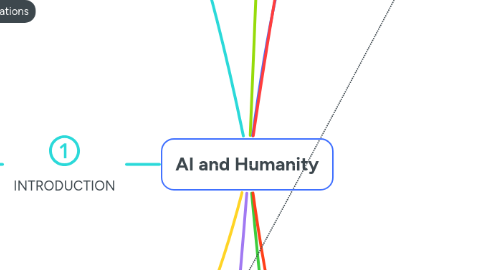
1. CHATBOT
1.1. Dialogflow
1.1.1. Agents
1.1.2. Intents
1.1.3. Intent matching algorithm
1.1.4. Training phrases
1.1.5. Responses
1.1.6. Entities
1.1.6.1. Intent parameter
1.1.6.2. List entities
1.1.7. Context
1.1.7.1. Follow up intent
1.1.7.2. Controls flow of conversation
1.1.8. Knowledge connectors
1.1.9. Integration
2. EMOTIONS
2.1. Categorical representations of emotions
2.1.1. Paul Ekman
2.1.1.1. Tribe experiment
2.1.1.2. FACS
2.1.1.3. 7 universal emotions
2.1.2. Blind athletes
2.2. Sentiment analysis
2.2.1. Dictionary based
2.2.2. Feature extraction
2.2.2.1. One hot encoding
2.2.2.2. Word embeddings training algorithms
2.2.2.3. Word embeddings
2.2.2.3.1. Word similarities
2.2.2.3.2. Relationship between words
2.2.2.4. Bag of words
2.2.3. Logistic regression
2.3. Dimensional representations of emotions
2.3.1. VAD model
2.3.1.1. Valence, arousal, dominance
2.3.2. Euclidean distance
2.4. Artificial neuron
2.5. Social reality
2.6. How humans express emotions
2.6.1. Multimodality approach
2.6.1.1. EEG
2.6.1.2. Facial modality
2.6.1.3. Voice modality
2.6.2. Beyond lab into the wild
2.6.3. Real world applications
2.6.3.1. Privacy issues
3. INTRODUCTION
3.1. Anthropomorphism
3.2. AI milestones
3.3. AI, ML, DL
3.4. AI applications
4. VISUAL PERCEPTION
4.1. Humans
4.1.1. Eye
4.1.1.1. Retina
4.1.1.1.1. Photoreceptor
4.1.1.1.2. Photopigment
4.1.1.1.3. Bipolar cells
4.1.1.1.4. Horizontal cells
4.1.1.2. Fovea
4.1.1.3. Saccades
4.1.2. Attention
4.1.2.1. Overt
4.1.2.2. Covert
4.2. Computers
4.2.1. RGB Channels
4.2.2. Pixels and Greyscale
4.2.3. Object Recognition
4.2.4. Convolutional Neural Networks (CNNs)
4.2.4.1. Convolutional layers
4.2.4.1.1. Convolutional layers have filters which are used to detect patterns
4.2.4.2. Feature Visualisation
4.2.5. Attention
4.2.5.1. Hard attention
4.2.5.2. Soft attention
5. External Themes
5.1. Privacy
5.1.1. AI in targeted advertising
5.1.1.1. selling people's personal data for corporations to maximise profit
5.1.1.1.1. ethical concerns about privacy
5.1.1.2. AI uses data to deliver ads to people that meet a certain criteria
5.2. Ethics
5.2.1. Self driving cars
5.2.1.1. Who is responsible for the deaths caused? AI? Manufacturer? Driver?
5.2.1.2. Predetermined decisions like would rather hit an old man than a young child
5.2.2. Discrimination
5.2.2.1. discrimination in facial recognition (black people identified as gorilla)
5.3. Beneficial
5.3.1. Gene identification / Biodata recognition to solve crimes
5.3.2. Neurolink technology
5.3.2.1. Regain the ability to function even if suffering from paralysis
5.3.3. AI reunites holocaust survivor with childhood photo
5.4. Detrimental
5.4.1. Extensive AI network and IOT provides more loopholes & angles for cyberattacks (breach of privacy)
6. IDENTITY AND MEMORY
6.1. 11 Identity markers
6.2. Information storage
6.3. Databases
6.4. Blockchain
6.4.1. Hash function
6.4.2. Information integrity
6.4.3. Decentralisation
6.4.4. Consensus mechanism
6.4.4.1. Proof of work
6.4.4.1.1. Uses a competitive validation method to confirm transactions and add new blocks to the blockchain
6.4.4.2. Proof of stake
6.4.4.2.1. Uses randomly selected validators to confirm transactions and create new blocks.
6.4.5. Smart contract
6.4.6. Digital identity
6.5. Human memory
6.5.1. Neuron
6.5.2. Memory
6.5.3. Memory storage model
7. CONCERNS OF AI
7.1. Should humans be concerned about AI replacing jobs?
7.1.1. Yes
7.1.1.1. Jobs will be replaced by AI, thus humans will lose their jobs
7.1.1.1.1. Midjourney AI
7.1.2. No
7.1.2.1. More jobs would be created in the future
7.1.2.2. Humans are still needed to manage and update AI
7.1.2.3. Humans can work hand in hand with AI
7.1.2.4. Increase worker productivity
7.2. Accountability
7.2.1. AI makes questionable decisions, who is held accountable?
7.3. Loss of privacy
7.3.1. Information sold by companies?
8. TOWARDS A SUSTAINABLE FUTURE
8.1. Definition: meeting the needs of the present without compromising the ability of future generations to meet their own needs.
8.2. Why is it important?
8.2.1. If the planetary boundaries are crossed, the devastating, large-scale changes to the environment are irreversible
8.3. Why is sustainability difficult?
8.3.1. Capitalism & Industrial Revolution
8.3.2. Corruption in Centralised Institutions
8.3.3. Compulsion
8.4. How can it be achieved?
8.4.1. Circular Economy
8.4.2. Carbon Management
8.4.2.1. Electric Vehicles
8.4.3. Consumer Behaviour
8.5. Contributions of AI
8.5.1. Sense
8.5.1.1. Distilling raw data into actionable information
8.5.2. Predict
8.5.2.1. Improving predictions (accuracy)
8.5.3. Optimize
8.5.3.1. Optimising and managing complex systems
8.5.4. Model
8.5.4.1. Accelerating scientific modelling and discovery
9. COMMUNICATION
9.1. Communication models
9.1.1. Transmission
9.1.2. Interaction
9.1.3. Transaction
9.2. Language and meaning
9.2.1. Triangle of meaning
9.2.1.1. Thought
9.2.1.2. Symbol
9.2.1.3. Referent
9.2.2. Dictionary
9.2.2.1. Letters
9.2.3. Grammar
9.3. Non verbal communication
9.4. Machine to Machine communication
9.4.1. Internet
9.4.2. TCP/IP protocol
9.4.3. ASCII Table
9.4.4. Bits
9.4.5. IOT
9.4.6. CMC
9.4.7. Turing test
